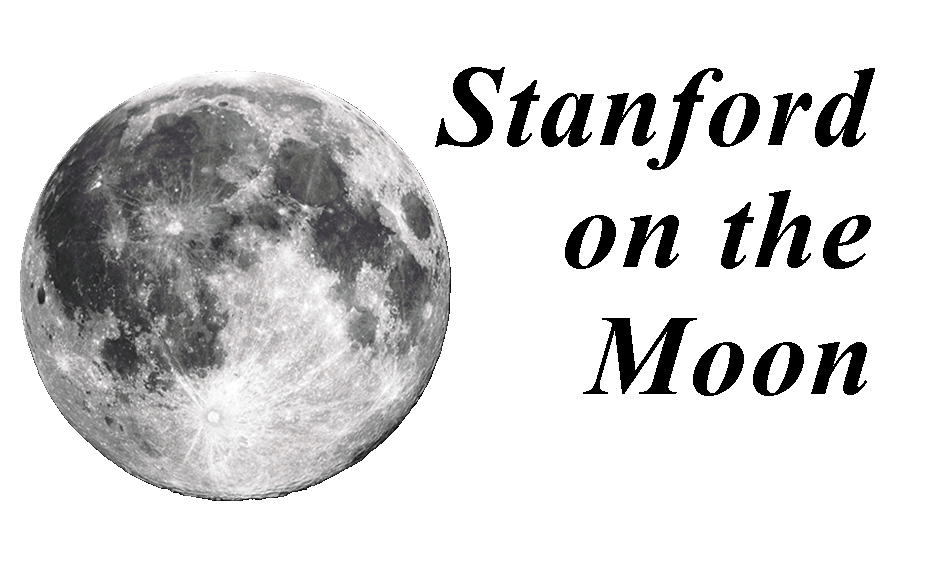 |
Stanford
On The Moon
Interdepartmental
Lunar Network
|
NASA Ames at Stanford |
Gregory
T.A. Kovacs
Professor of Electrical Engineering and Medicine
Room CISX-202, Paul Allen Building
Stanford, CA 94305-4075
kovacs@cis.stanford.edu
|
Development
of biological space payloads, human (medical) physiologic monitors for spaceflight,
and miniaturized instrumentation for extreme environments. |
Antonio
J. Ricco, Ph.D.
(on assignment from Stanford University)
NASA Ames Research Center
Small Spacecraft Division
ajricco@stanford.edu |
At Stanford and NASA, development of remote, autonomous miniaturized analytical systems for fundamental space studies, particularly of living organisms; at Dublin City University, development of next-generation integrated point-of-care medical diagnostic devices. |
School
of Engineering |
| Department
of Aeronautics and Astronautics |
Daniel
B. DeBra
Edward C. Wells Professor Emeritus
Department of Aero and Astro
277 Durand mc 4035
Stanford University
Stanford, CA 94305-4035
ddebra@stanford.edu
|
Research
Interests: Professor DeBra is involved with robotic space research. He collaborates
with Stanford physicists on three projects: Gravity Probe-B (GP-B), Space
Test of the Equivalence Principle (STEP), and the vibration isolation of
a gravity-wave antenna. These involve satellite control of attitude and
translation and the development of instruments of extraordinary precision
and accuracy. |
Bob
Twiggs
Space Systems Development Laboratory (SSDL)
Department of Aero and Astro
Durand 271
Stanford University
496 Lomita Mall
Stanford, CA 94305
Bob.Twiggs@Stanford.edu
|
Research
Interests: Professor Twiggs' main interest is in the development, launch
and operation of small low-cost satellites for space applications feasibility
demonstrations and the space qualification of new spacecraft components.
He is also involved in the development of low-cost satellite communications
for command, control and data acquisition at remote earth locations, and
in the miniaturization development of space experiments for low-cost spacecraft
missions. |
Department
of Electrical Engineering |
Ronald
N. Bracewell
|
Research
in image construction, fast algorithms and solar physics, and more specifically
computerized x-ray tomography, radio astronomy, astronomical imaging, antennas,
large moving structures, Fourier analysis, image and reconstruction, and
Hartley transform. The “Friends
of Bracewell” attempted to halt the demolition
of five 60’ antenna dishes built by Professor Bracewell and utilized
for eleven years to produce the first automatically printed daily solar
weather maps, as well as in support of the first human Moon landing. |
Umran
S. Inan
Professor of Electrical Engineering
Packard Bldg #355
Stanford, CA 94305-9515
Inan@ee.stanford.edu
|
Research
in ionospheric and magnetospheric physics, VLF/LF remote sensing, lightning
research, wave-particle interactions, radiation belt dynamics, and applied
electromagnetics, especially ionospheric and magnetospheric physics, lightning
discharges, wave propagation and scattering, FLV/LF remote sensing, satellite
observations of plasma waves, dynamics of the radiation belts, wave-particle
interactions, planetary plasma waves, and active wave-injection experiments. |
Bruce
Lusignan
Associate Professor
Department of Electrical Engineering
Packard Building, Room 237
Stanford University
Stanford, CA 94305
lusignan@ee.stanford.edu
|
Research
Interests: Director, Communications Satellite Planning Center, and Center
for International Cooperation in Space Communications Networks, Ground Station
Engineering, and Digital and Photonic Switch Design. Professor Lusignan
designs and introduces advanced communications and space systems, including
satellite television stations, low cost two-way voice stations, and high
data-rate stations. He directs an international planning effort for cooperative
exploration of Mars. He directs a weekly seminar on war and peace, trade
and environment, and poverty and prejudice. Professor Lusignan is teaching
a course on Lunar Utilization in 2005. |
Madihally
(Sim) Narasimha
Consulting Professor of Electrical Engineering
Space, Telecommunications,and
Radioscience Laboratory (STAR Lab)
350 Serra Mall, David Packard #321
Stanford University
Stanford, CA 94305
sim@nova.stanford.edu
|
Research
Interests: Signal processing in telecommunications systems, with current
research in the development of 1 Gbps and 10 Gbps transceiver ships for
twisted pair communications. |
| Dick
Simpson
Research
Associate
350 Serra Mall, David Packard #332
Stanford, CA 94305-9515
rsimpson@magellan.stanford.edu
|
Research
Interests: Active radio probing of the solar system with special emphasis
on planetary surfaces, their scattering properties, and what may be learned
about their composition and texture from such measurements. Present work
is focused primarily on Mars, but have been involved intermittently in the
search for water ice on the Moon over the past decade. |
Department
of Mechanical Engineering |
Mark
A. Cappelli
Associate Professor, Thermosciences Division
Department of Mechanical Engineering
Building 520 -- Room 520J
Stanford, CA 94305-3032
cap@stanford.edu
|
Research
Interests: Plasma Spectroscopy, Plasma Propulsion, Plasma and Combustion
Synthesis of Materials. He is currently a member of the Editorial Board
of Diamond Films and Technology. He is also secretary of the Electric Propulsion
Technical Committee of the American Institute for Aeronautics and Astronautics. |
Christopher
Jacobs
Associate Professor (Research) of
Mechanical Engineering and
Of Orthopedic Surgery
Durand, 233 BME
Stanford, CA 94305-4038
Christopher.Jacobs@stanford.edu
|
Research
in the area of bone loss in microgravity and specifically how cells in bone
sense and respond to mechanical loading. |
School
of Humanities and Sciences |
Department
of Physics |
Vahe
Petrosian
Professor of Physics and Applied Physics
Room 302c, Varian Physics Building
382 Via Pueblo Mall
Stanford, CA 94305-4060
vahe@astronomy.stanford.edu
|
Research
Interests: Theoretical astrophysics with concentration on high energy astrophysical
processes in solar and stellar flares, gamma-ray bursts, accretion disks
of stellar and active galactic black holes and clusters of galaxies, and
in cosmology; early phase of the universe, the evolution of galaxies and
quasars, arcs in clusters of galaxies, and gravitational lensing. |
| Philip
H. Scherrer
Professor
Hansen Experimental Physics Lab
455 Via Palou
Stanford, CA 94305-4085
pscherrer@solar.stanford.edu
|
Research
Interests: Detection and prediction of solar variability and the effect
of solar variability on the space environment. |
School
of Medicine |
Daniel
Kraft, MD
Hematology/Oncology/BMT
Beckman Center, B-265
Stanford, CA 94305
daniel.kraft@stanford.edu
|
Research
Interests: Space Life Sciences |
| |
| |
|
|
|
|
